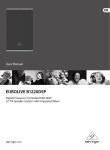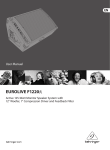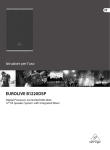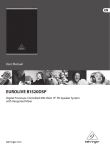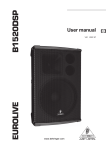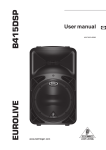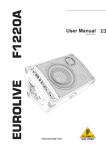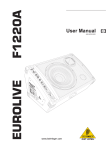Download Behringer Eurolive B1220DSP User manual
Transcript
User Manual EUROLIVE B1220DSP Digital Processor-Controlled 600-Watt 12" PA Speaker System with Integrated Mixer 2 EUROLIVE B1220DSP User Manual Table of Contents Thank you........................................................................ 2 Important Safety Instructions....................................... 3 Legal Disclaimer.............................................................. 3 Limited warranty............................................................. 3 1. Introduction................................................................ 4 1.1 Before you get started....................................................... 4 1.1.1 Shipment........................................................................... 4 1.1.2 Initial operation.............................................................. 4 1.1.3 Online registration........................................................ 4 2. Control Elements and Connections.......................... 4 3. Setting Up the B1220DSP.......................................... 5 3.1 Tweeter.................................................................................... 5 3.2 How to avoid feedback..................................................... 5 4. Application Examples................................................ 5 4.1 Presentations......................................................................... 5 4.2 PA systems............................................................................. 6 4.3 Other uses.............................................................................. 7 5. Installation.................................................................. 7 6. Specifications.............................................................. 7 Thank you Thank you very much for expressing your confidence in BEHRINGER products by purchasing the EUROLIVE B1220DSP. The B1220DSP is a state-of-the-art digitally controlled PA speaker system that will simply blow you away. Its bi-amped 600-Watt engine drives a high-efficiency 12" woofer for brutal punch and a 1.75" titanium driver for high-end resolution. The built-in mixer allows you to run the show without any extra equipment. A powerful 24-bit DSP controls the crossover, a dual compressor/limiter, phase and time corrections and even a noise gate. The intelligent dynamic EQ makes sure your system sounds perfect at any sound level. 3 EUROLIVE B1220DSP User Manual Important Safety Instructions Terminals marked with this symbol carry electrical current of sufficient magnitude to constitute risk of electric shock. Use only high-quality professional speaker cables with ¼" TS or twist-locking plugs pre-installed. All other installation or modification should be performed only by qualified personnel. This symbol, wherever it appears, alerts you to the presence of uninsulated dangerous voltage inside the enclosure - voltage that may be sufficient to constitute a risk of shock. This symbol, wherever it appears, alerts you to important operating and maintenance instructions in the accompanying literature. Please read the manual. Caution To reduce the risk of electric shock, do not remove the top cover (or the rear section). No user serviceable parts inside. Refer servicing to qualified personnel. Caution To reduce the risk of fire or electric shock, do not expose this appliance to rain and moisture. The apparatus shall not be exposed to dripping or splashing liquids and no objects filled with liquids, such as vases, shall be placed on the apparatus. 9. Do not defeat the safety purpose of the polarized or grounding-type plug. A polarized plug has two blades with one wider than the other. A grounding-type plug has two blades and a third grounding prong. The wide blade or the third prong are provided for your safety. If the provided plug does not fit into your outlet, consult an electrician for replacement of the obsolete outlet. 10. Protect the power cord from being walked on or pinched particularly at plugs, convenience receptacles, and the point where they exit from the apparatus. 11. Use only attachments/accessories specified by the manufacturer. 12. Use only with the cart, stand, tripod, bracket, or table specified by the manufacturer, or sold with the apparatus. When a cart is used, use caution when moving the cart/apparatus combination to avoid injury from tip-over. 13. Unplug this apparatus during lightning storms or when unused for long periods of time. 14. Refer all servicing to qualified service personnel. Servicing is required when the apparatus has been damaged in any way, such as power supply cord or plug is damaged, liquid has been spilled or objects have fallen into the apparatus, the apparatus has been exposed to rain or moisture, does not operate normally, or has been dropped. 15. The apparatus shall be connected to a MAINS socket outlet with a protective earthing connection. 16. Where the MAINS plug or an appliance coupler is used as the disconnect device, the disconnect device shall remain readily operable. Caution These service instructions are for use by qualified service personnel only. To reduce the risk of electric shock do not perform any servicing other than that contained in the operation instructions. Repairs have to be performed by qualified service personnel. 1. Read these instructions. 2. Keep these instructions. 3. Heed all warnings. 4. Follow all instructions. 5. Do not use this apparatus near water. 6. Clean only with dry cloth. 7. Do not block any ventilation openings. Install in accordance with the manufacturer’s instructions. 8. Do not install near any heat sources such as radiators, heat registers, stoves, or other apparatus (including amplifiers) that produce heat. LEGAL DISCLAIMER TECHNICAL SPECIFICATIONS AND APPEARANCES ARE SUBJECT TO CHANGE WITHOUT NOTICE AND ACCURACY IS NOT GUARANTEED. BEHRINGER, KLARK TEKNIK, MIDAS, BUGERA, AND TURBOSOUND ARE PART OF THE MUSIC GROUP (MUSIC-GROUP.COM). ALL TRADEMARKS ARE THE PROPERTY OF THEIR RESPECTIVE OWNERS. MUSIC GROUP ACCEPTS NO LIABILITY FOR ANY LOSS WHICH MAY BE SUFFERED BY ANY PERSON WHO RELIES EITHER WHOLLY OR IN PART UPON ANY DESCRIPTION, PHOTOGRAPH OR STATEMENT CONTAINED HEREIN. COLORS AND SPECIFICATIONS MAY VARY FROM ACTUAL PRODUCT. MUSIC GROUP PRODUCTS ARE SOLD THROUGH AUTHORIZED FULLFILLERS AND RESELLERS ONLY. FULLFILLERS AND RESELLERS ARE NOT AGENTS OF MUSIC GROUP AND HAVE ABSOLUTELY NO AUTHORITY TO BIND MUSIC GROUP BY ANY EXPRESS OR IMPLIED UNDERTAKING OR REPRESENTATION. THIS MANUAL IS COPYRIGHTED. NO PART OF THIS MANUAL MAY BE REPRODUCED OR TRANSMITTED IN ANY FORM OR BY ANY MEANS, ELECTRONIC OR MECHANICAL, INCLUDING PHOTOCOPYING AND RECORDING OF ANY KIND, FOR ANY PURPOSE, WITHOUT THE EXPRESS WRITTEN PERMISSION OF MUSIC GROUP IP LTD. ALL RIGHTS RESERVED. © 2013 MUSIC Group IP Ltd. Trident Chambers, Wickhams Cay, P.O. Box 146, Road Town, Tortola, British Virgin Islands LIMITED WARRANTY For the applicable warranty terms and conditions and additional information regarding MUSIC Group’s Limited Warranty, please see complete details online at www.music-group.com/warranty. 4 EUROLIVE B1220DSP User Manual 1. Introduction ◊ Please read this manual to familiarize yourself with the control elements of the unit and its functions. After you have carefully read this manual, keep it for future reference. 2. Control Elements and Connections (2) (7) (10) (8) (9) (3) (4) 1.1 Before you get started 1.1.1 Shipment Your B1220DSP was carefully packed at the assembly plant to assure secure transport. Should the condition of the cardboard box suggest that damage may have taken place, please inspect the unit immediately and look for physical indications of damage. ◊ Damaged equipment should NEVER be sent directly to us. Please inform the dealer from whom you acquired the unit immediately as well as the transportation company from which you took delivery. Otherwise, all claims for replacement/repair may be rendered invalid. ◊ Please always use the original packaging to avoid damage due to storage or shipping. ◊ Never let unsupervised children play with the B1220DSP or with its packaging. ◊ Please dispose of all packaging materials in an environmentally friendly fashion. 1.1.2 Initial operation Be sure that there is enough space around the unit for cooling. To avoid overheating, do not place the B1220DSP on top of power amps or near radiators, etc. The mains connection is made using the enclosed power cord and a standard IEC receptacle. It meets all international safety certification requirements. ◊ Please make sure that all equipment is properly grounded at all times. For your own safety, never remove or disable the ground conductor of the unit or of the AC power cord. Important note concerning installation: ◊ The sound quality may diminish within the range of powerful broadcasting stations and high-frequency sources. Increase the distance between the transmitter and the device and use shielded cables for all connections. (1) (11) (12) (13) (6) (5) Fig. 2.1: Control elements and connections (1) Power is supplied via an IEC connector. The matching cable is provided with the unit. (2) Use the POWER switch to turn on the B1220DSP. Before connecting the unit to the power mains, ensure that the POWER switch is in OFF position. ◊ Attention: The POWER switch does not fully disconnect the unit from the mains. To disconnect the unit from the mains, pull out the main cable plug or appliance coupler. When installing the product, ensure the plug or appliance coupler is readily operable. Unplug the power cord completely when the unit is not used for long periods of time. (3) Use the LEVEL control to adjust the signal gain of the MIC/LINE inputs. Before you connect or disconnect a signal source to or from one of the inputs, please turn the corresponding control fully to the left. Once the signal source is connected, increase the volume as desired by turning the control clockwise. Always make sure that the CLIP LED (4) does not light up at all or with signal peaks only. Line-level signals: Devices with high output levels (e.g. the outputs of mixing consoles or CD players) only need little gain. In this case, the LEVEL control will mostly be positioned somewhere in the area marked “LINE” (left half of the control range). 1.1.3 Online registration Microphone signals Please register your new BEHRINGER equipment right after your purchase by visiting http://behringer.com and read the terms and conditions of our warranty carefully. Low-level microphone signals need more gain. When microphones are used, the control will be positioned in the MIC area (right half of the control range). Should your BEHRINGER product malfunction, it is our intention to have it repaired as quickly as possible. To arrange for warranty service, please contact the BEHRINGER retailer from whom the equipment was purchased. Should your BEHRINGER dealer not be located in your vicinity, you may directly contact one of our subsidiaries. Corresponding contact information is included in the original equipment packaging (Global Contact Information/European Contact Information). Should your country not be listed, please contact the distributor nearest you. A list of distributors can be found in the support area of our website (http://behringer.com). Registering your purchase and equipment with us helps us process your repair claims more quickly and efficiently. Thank you for your cooperation! ◊ We would like to draw your attention to the fact that extremely loud sound levels may damage your hearing as well as your headphones/loudspeakers. Turn the LEVEL control fully to the left before you switch on the unit. Be careful to select a suitable volume at all times. (4) The CLIP LED lights up when the input signal level is too high. In this case, turn the LEVEL control (3) to the left until the LED goes out or only lights up at peak levels. (5) Use the MIC/LINE inputs (XLR connectors) for connecting audio signals. (6) The LINE OUT XLR jack provides the signal with no additional gain applied in order to connect another loudspeaker, for example. The output signal is a mix of both input signals. (See Chapter 4.2 for more information on how to use several loudspeakers) 5 EUROLIVE B1220DSP User Manual The B1220DSP is equipped with a 2-band tone control. Each band allows you to apply a maximum boost/cut of 15 dB, in its center position the equalizer is set to neutral. (7) Use the EQ HIGH control to cut or boost the treble range by 15 dB. The cut-off frequency is 12 kHz. (8) Use the EQ LOW control to cut or boost the bass range by 15 dB. The cut-off frequency is 100 Hz. (9) The B1220DSP features a high-pass filter with a slope of 24 dB/oct. to eliminate unwanted low-frequency content, such as pop sounds produced by hand-held microphones, or rumble or wind noise when using high-sensitivity microphones. The LOW CUT control adjusts the cut-off frequency. If you want to use the B1220DSP in combination with a subwoofer, you can use the high-pass filter to lower the bass range reproduced by the subwoofer. This allows you to operate the B1220DSP even without an external frequency crossover. Set the cut-off frequency to the highest frequency that can be reproduced by the subwoofer. Fig. 3.1: B1220DSP mounted on a stand 3.2 How to avoid feedback Always place the microphones (viewed from the audience) behind the B1220DSP, never in front of it (Fig. 3.2). When you wish to adjust the controls on the B1220DSP while holding a microphone, please approach the loudspeaker from the rear to avoid feedback. (10) The CONTOUR switch governs the dynamic contour filter: SPEECH Setting the CONTOUR switch to SPEECH (switch not pressed) will optimize the frequency response for speech applications. This ensures better intelligibility. MUSIC Setting the CONTOUR switch to MUSIC (switch pressed) will optimize the frequency response for music playback. (11) The TIMED TURNOFF switch activates the automatic turn-off function: ON When the switch is actuated (ON position), the automatic switch-off is active. The loudspeaker is turned off automatically when it receives no signal for more than 3 minutes. As soon as a signal is received, the loudspeaker is switched back on. OFF If the switch is not actuated (OFF position) then the speaker remains switched on and can only be deactivated via the POWER switch (2). (12) A noise-gate allows you to eliminate unwanted noise during signal pauses. This is done by a circuit that mutes the output when the signal level drops below a preset threshold. Use the NOISE GATE control to determine the threshold below which the noise-gate closes. (13) The TH LED lights up as soon as the signal level drops below the threshold value adjusted with the NOISE GATE control (12) (the noise-gate closes). 3. Setting Up the B1220DSP The sound of your B1220DSP largely depends on the room acoustics. Please observe the following hints to get the most out of your B1220DSP. 3.1 Tweeter High frequencies are the very part of the audio spectrum that ensure a clear perception of sound and speech intelligibility. Although these frequencies can be located most easily, they are also the first to be blocked acoustically. We therefore recommend that you set up your speakers on speaker stands (not included), so that the tweeter radiates its signals slightly above the heads of the audience. This will ensure both an optimum dispersion of the high-frequency content and a considerably improved speech intelligibility. Fig. 3.2: Right and wrong positioning To avoid feedback, it is recommended that you carefully select and direct the microphones used. Basically, you should use microphones with a high directivity, i.e. with a cardioid or hyper-cardioid polar pattern. Never hold a microphone so that its main pick-up area points directly towards the loudspeaker. When you hold it with its less sensitive side towards the speaker box, you can move closer to the speaker. ◊ If you encounter persistent feedback problems, consider using our proven FEEDBACK DESTROYER PRO FBQ2496 for line-level signals. For signals with line or microphone level, we recommend our BEHRINGER SHARK DSP110. 4. Application Examples 4.1 Presentations With just one B1220DSP and one or two dynamic microphones, you can set up a basic audio system with very little effort. Thanks to the built-in mixer section, you can connect the microphones directly to the B1220DSP. Mount the B1220DSP on a speaker stand for optimum presentation and intelligibility of announcements. If one B1220DSP is not enough, you can, of course, use a second or even more loudspeakers. Connecting microphones: • Turn the LEVEL controls (3) fully to the left • Connect your microphones to the MIC/LINE inputs • Switch on the B1220DSP • Turn the LEVEL controls (3) gradually clockwise to set the volume of your choice. Observe the CLIP LEDs while adusting the volume. Make sure they never shine constantly but only light up at peak levels • Use the LINE OUT connector (6) to connect an (optional) second B1220DSP 6 EUROLIVE B1220DSP User Manual ◊ Never place a microphone directly in front of the loudspeaker owing to danger of feedback! When operating the B1220DSP make sure that you always stay behind the loudspeaker to avoid feedback. EUROLIVE B1220DSP (optional) EUROLIVE B1220DSP Instead of a mixing console, you can also connect a stereo signal source, e.g. a CD player. In this case, one B1220DSP is connected to each of the outputs of the signal source. Connecting a stereo signal source: • Turn the LEVEL controls (3) fully to the left • Connect the left output of the stereo device to the MIC/LINE connector of the left loudspeaker, and the right stereo device output to the MIC/LINE connector of the right loudspeaker • Switch on the B1220DSP • Raise the output level of the stereo signal source (if available), ensuring that it does not overload the input • Turn the LEVEL controls (3) gradually clockwise to set the volume of your choice Linking several B1220DSP: Fig. 4.1: Connecting microphones 4.2 PA systems PA is short for “public address” and includes all applications that involve a larger audience. This example uses a mixing console as its central unit for system operation and connections. All microphones, feeding and effects devices, etc. are connected to the mixing console, which is then linked to the B1220DSP. If you need more sound pressure, for example in larger rooms, simply increase the number of loudspeakers on each stereo side. You could place two B1220DSP on each stereo side and interconnect them (see Fig. 4.3). The loudspeakers can be stacked or placed one beside the other. When you stack the speakers, the carrying recesses built into the cabinets ensure the stability of the stack. You can connect a microphone, a mixing console or stereo signal source. • Connect the LINE OUT connector (6) of the first B1220DSP to the MIC/LINE input of the next B1220DSP Connecting a mixing console: ◊ With several B1220DSP speakers connected to each other, their input • Turn the LEVEL controls (3) fully to the left • Connect the left output of the mixing console to the MIC/LINE connector of the left loudspeaker, and the right mixing console output to the right loudspeaker • Switch on the B1220DSP impedance will be reduced by half (two B1220DSPs), or to one third (three B1220DSPs), etc. Always use the output impedance of the mixing console as a basis for your calculations! EUROLIVE B1220DSP EUROLIVE B1220DSP • Raise the level of the mixing console output to a level of 0 dB • Turn the LEVEL controls (3) gradually clockwise to set the volume of your choice. When the CLIP LEDs light up, this indicates that the maximum volume has been reached Mic/Line 1 Mic/Line 1 EUROLIVE B1220DSP (L) EUROLIVE B1220DSP (R) Line Out Line Out Mic/Line 1 Main Out L Main Out L Main Out R X2442USB Fig. 4.3: Linking several B1220DSP speakers X2442USB Fig. 4.2: Connecting a mixing console Mic/Line 1 Main Out R 7 EUROLIVE B1220DSP User Manual 4.3 Other uses Monitoring: When used as a monitor, the B1220DSP receives its audio signal from the monitor or aux output of the mixing console. If additional B1220DSPs are to be used, you can loop the audio signal from the first speaker to the next B1220DSP using the line output. The sound and volume of each B1220DSP can be adjusted with their own operating elements (3) (LEVEL), (7) (EQ HIGH) and (8) (EQ LOW). Keyboard amplification: Guitarists and bassists usually have their own amplifiers on stage to make sure they can hear their own instrument - even when no monitors are used. vIn wparticular on smaller stages, the power delivered by these amps is enough to match the volume produced by other sound sources on stage. Things are different with keyboards and synthesizers as these usually have no built-in speakers. The B1220DSP allows you to connect and mix two keyboards. If you want to play more than two keyboards, you can use a submixer (e.g. MicroMIX MX400) to mix down the signals and route them to the B1220DSP using submixer output connectors. The second MIC/LINE input can be used to connect the monitor signal from the PA mixing console, so that you can also hear the other members of your band. 5. Installation Both audio inputs and outputs of the BEHRINGER B1220DSP are fully balanced. To maximize interference compensation, try to establish balanced connections to other equipment, whenever possible. ◊ Make sure that only competent people install your B1220DSP. They must be sufficiently earthed during and after the installation process. Otherwise, electrostatic discharges may negatively affect the operating characteristics of your equipment. Balanced use with XLR connectors 2 1 3 input 1 = ground/shield 2 = hot (+ve) 3 = cold (-ve) 1 2 3 output For unbalanced use, pin 1 and pin 3 have to be bridged Fig. 5.1: XLR connector 6. Specifications Audio Inputs MIC/LINE (2) XLR (balanced) Input impedance 27 kOhm Sensitivity -40 to +10 dBu Audio Outputs LINE OUT XLR (balanced) Output impedance 120 Ohm Processing DSP 24-bit Motorola AD/DA converter 24-bit / 48 kHz Limiter dual protection for woofer and driver Dynamic EQ dual parametric EQ’s NOISE GATE variable (off to -30 dB) TIMED TURNOFF switchable (3 min < -45 dBr) CONTOUR switchable speech / music contour EQ HIGH +/-15 dB (12 kHz) EQ LOW +/-15 dB (100 Hz) LOW CUT 40 - 160 Hz (24 dB/Oct.) Loudspeaker System Data Frequency range 45 Hz to 20 kHz Crossover Butterworth, 1.7 kHz, 24 dB/Oct. Max. sound pressure level 127 dB @ 1 m Dispersion angle 90° x 45° Output Power Low-Frequency Range RMS @ 1% THD 320 W @ 8 Ohm Peak Power 460 W @ 8 Ohm High-Frequency Range RMS @ 1% THD 80 W @ 8 Ohm Peak Power 140 W @ 8 Ohm 8 EUROLIVE B1220DSP User Manual Power Supply Mains Voltage/Fuses 100 V~, 50/60 Hz T 6,3 A H 250 V 120 V~, 60 Hz T 6,3 A H 250 V 220 V~, 50 Hz T 4,0 A H 250 V 230 V~, 50 Hz T 4,0 A H 250 V Power consumption max. 650 W Mains connector Standard IEC receptacle Dimensions/Weight Dimensions (W x H x D) approx. 397 x 638 x 406 mm approx. (15.5 x 25.1 x 16") Weight approx. 31.3 kg approx. (68 lbs.) BEHRINGER is constantly striving to maintain the highest professional standards. As a result of these efforts, modifications may be made from time to time to existing products without prior notice. Specifications and appearance may differ from those listed or illustrated. 9 EUROLIVE B1220DSP User Manual FEDERAL COMMUNICATIONS COMMISSION COMPLIANCE INFORMATION EUROLIVE B1220DSP Responsible Party Name: MUSIC Group Services US Inc. Address: 18912 North Creek Parkway, Suite 200 Bothell, WA 98011, USA Phone Number: +1 425 672 0816 EUROLIVE B1220DSP complies with the FCC rules as mentioned in the following paragraph: This equipment has been tested and found to comply with the limits for a Class B digital device, pursuant to part 15 of the FCC Rules. These limits are designed to provide reasonable protection against harmful interference in a residential installation. This equipment generates, uses and can radiate radio frequency energy and, if not installed and used in accordance with the instructions, may cause harmful interference to radio communications. However, there is no guarantee that interference will not occur in a particular installation. If this equipment does cause harmful interference to radio or television reception, which can be determined by turning the equipment off and on, the user is encouraged to try to correct the interference by one or more of the following measures: • Reorient or relocate the receiving antenna. • Increase the separation between the equipment and receiver. • Connect the equipment into an outlet on a circuit different from that to which the receiver is connected. • Consult the dealer or an experienced radio/TV technician for help. This device complies with Part 15 of the FCC rules. Operation is subject to the following two conditions: (1) this device may not cause harmful interference, and (2) this device must accept any interference received, including interference that may cause undesired operation. Important information: Changes or modifications to the equipment not expressly approved by MUSIC Group can void the user’s authority to use the equipment. We Hear You










